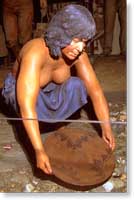 |
 |
||
|
Prospecting - Indian Gold Washing
Many Indians of both sexes were at work washing gold from the mud of a small spring. Their extraordinary skill was surprising. The women were dressed, but they exposed completely those parts of their persons which are carefully covered in more evil-minded lands. The division of labor they followed was this: the men dug and gave the mud to the children, who then carried it in baskets to the women. The women, lined up along the stream, then washed it in grass baskets of the most perfect construction. - Vicente Pérez Rosales Indian labor A Frenchman named Covillaud described his plan to exploit the Indians: I intend to show the Indians how to wash gold. I will pay them with glass beads, knives, handkerchiefs, tobacco and trinkets which they consider valuable. For any of these little articles they will work many hours, digging gold whose value they are not aware of. Almost immediately, Indians became targets of white miners. These aggressive newcomers thought nothing of running the Indians off from their diggings, stealing their gold, and killing them if that was the simplest thing to do. The miners are sometimes guilty of the most brutal acts with the Indians, such as killing the squaws and papooses. Such incidents have fallen under my notice that would make humanity weep and men disown their own race. - anon. Antonio Coronel witnessed a number of senseless massacres of Indians he was powerless to prevent. I could not continue to watch this horrible killing. The situation was so disgraceful that to kill an Indian in cold blood was the same as to hunt a hare or rabbit. Top: Miwok Miner, Photo by Christopher Richard Chinese Camp | Arrastra | Miwok Mining Site | Coyote Hole | Long Tom |
|||
 This scene is an Indian mining site in 1848. A
Miwok woman is panning with a watertight basket and a crevice tool. Gold had not been
valued in Indian culture. But when foreigners rushed in, the Indians immediately realized
its trade value. Maidu and Miwok Indians knew exactly where to look for gold, although
they had ignored it for centuries. In the first few months of the gold rush, some Indians
worked for white miners, and others mined on their own. They were very successful. Antonio
Coronel describes the arrival in his camp of seven Indians, each one with little sacks of
gold, shaped like a long sausage, from ten to twelve inches long. He realized that each of
those sacks, called pokes, contained nearly one pound of gold!
This scene is an Indian mining site in 1848. A
Miwok woman is panning with a watertight basket and a crevice tool. Gold had not been
valued in Indian culture. But when foreigners rushed in, the Indians immediately realized
its trade value. Maidu and Miwok Indians knew exactly where to look for gold, although
they had ignored it for centuries. In the first few months of the gold rush, some Indians
worked for white miners, and others mined on their own. They were very successful. Antonio
Coronel describes the arrival in his camp of seven Indians, each one with little sacks of
gold, shaped like a long sausage, from ten to twelve inches long. He realized that each of
those sacks, called pokes, contained nearly one pound of gold!